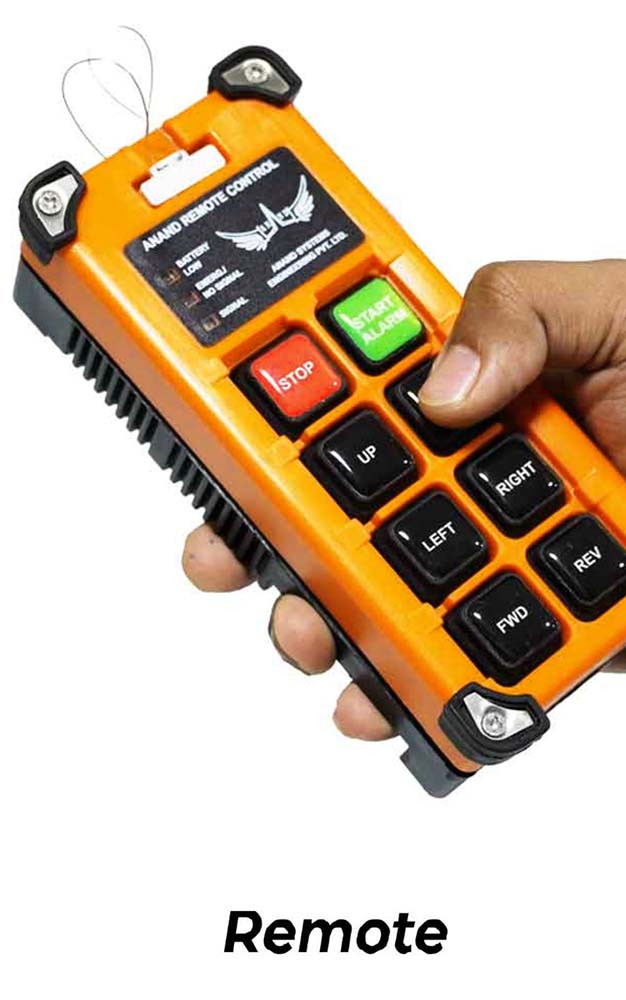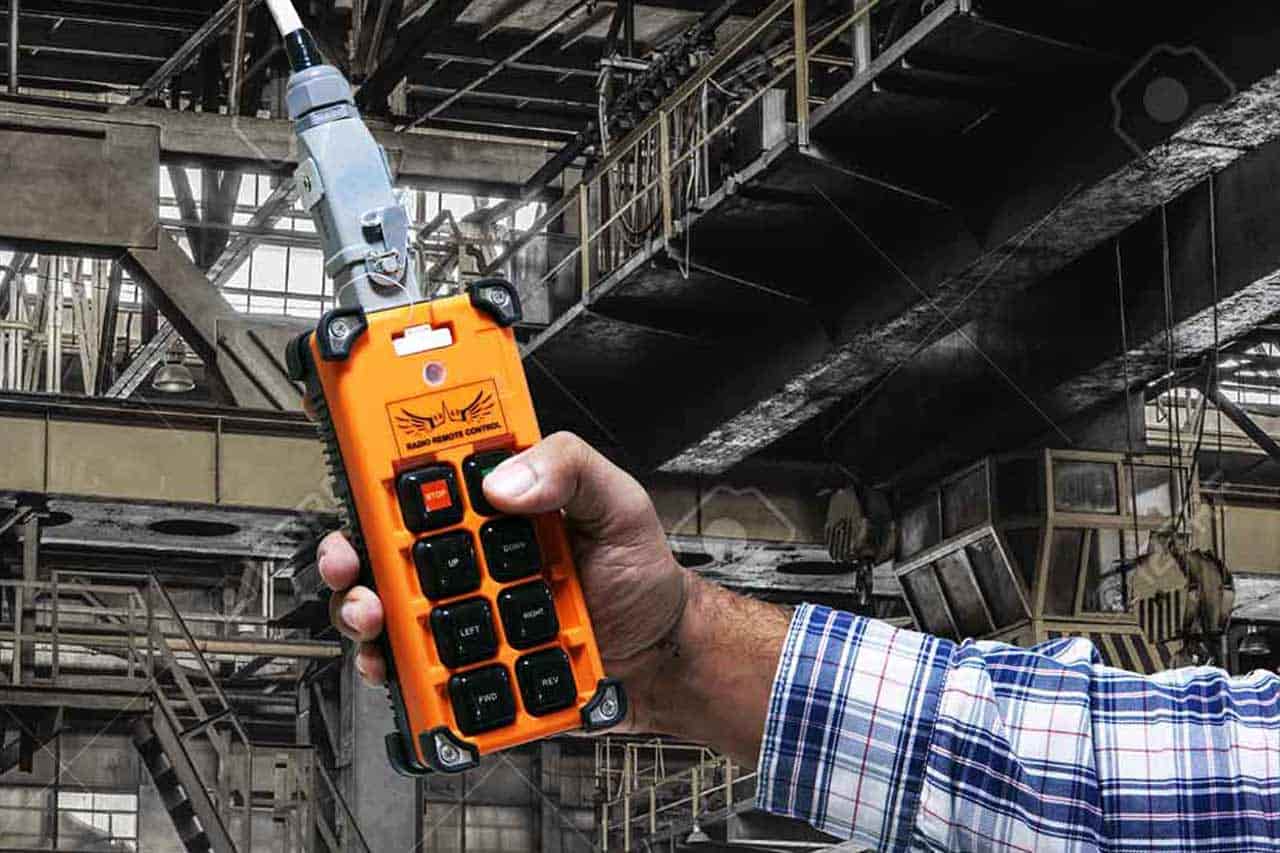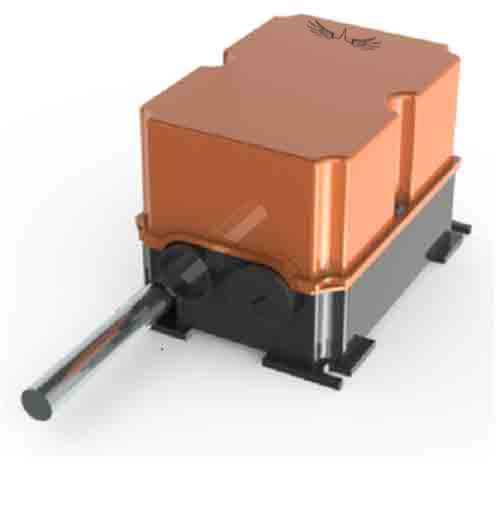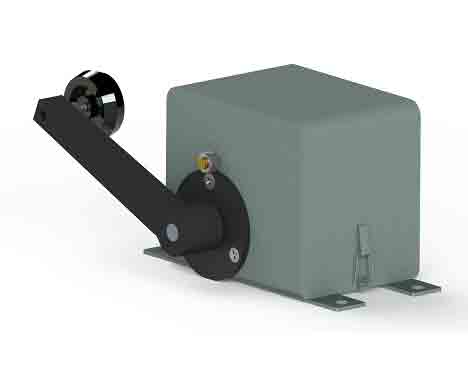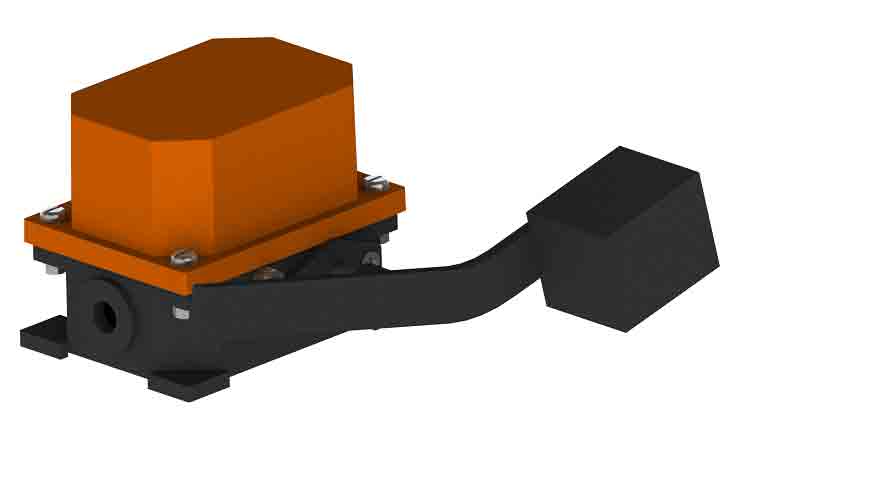EOT Cranes - Electric Overhead Travelling Cranes.

In todays Blog we will discover what are
EOT Cranes.
Where are they used? What are the different types of EOT Cranes?
So if you want to make sure that your knowledge of the EOT Cranes
is up to speed, you should get a lot of value from today’s content.
- EOT (Electric Overhead Traveling) Crane Configurations
- Parts of EOT Cranes
- Features of EOT Cranes
- Types of EOT Cranes
- Applications of EOT Cranes
- Malfunctions of EOT Cranes
- Comparison of EOT Cranes with Other Types of Cranes
- Conclusion
Introduction
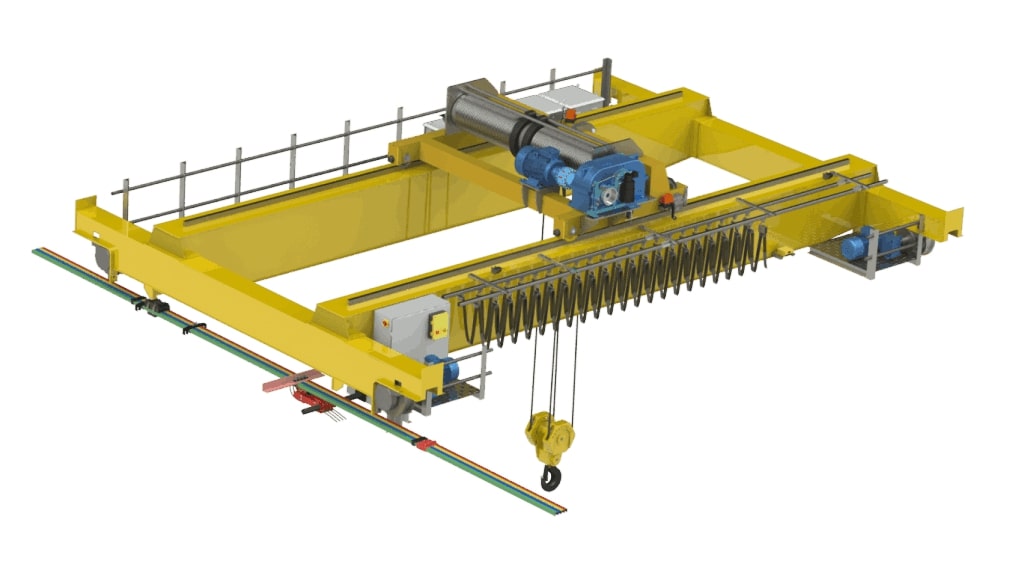
In 1876, Sampson Moore in England was the first Manufacturer of Electric Overhead Crane.
Moving a heavy or bulk load from one place to another crane mechanism is used, which reduces the manpower
and provides high productivity and efficient work.
EOT (Electric Overhead Traveling) crane is one of the types of overhead cranes, which is also called as
bridge cranes.
EOT cranes operate on electricity. It needs an operator or pendant station to control the functions of
the EOT crane.
It consists of a parallel runway connected with a traveling bridge. The hoist is mounted on a traveling
bridge. It is used for critical industrial applications.
An EOT has three working movements: Crane Hook Up and Down Lifting, Trolley Lateral Movement, and Crane
Long Traveling Longitudinal Motion
EOT (Electric Overhead Traveling) Crane Configurations
-
Under Running EOT Cranes
EOT cranes that are supported by the roof structure and run on the bottom flange of runway girders are known as under-running EOT cranes. These cranes have a small trolley dimension which allows them to utilize the maximum building width and height. Additionally, the under-running configuration allows for the use of existing ceiling girders for protecting the crane track. This configuration is best suited for applications where the crane must be installed in an existing building and space is limited. One of the major benefits of under-running EOT cranes is that they allow for a more efficient use of the available space in a facility. They also tend to be more cost-effective than top-running cranes since they do not require the installation of new runway beams. However, they do have a lower capacity range than top-running cranes, which limits their ability to handle heavy loads. -
Top Running EOT Cranes
EOT cranes that have a fixed rail or track system installed on the top of the runway beam are known as top-running EOT cranes. The top-running configuration does not have any limiting capacity range and can handle both small and huge loads. This configuration is best suited for new construction projects or for applications where the crane must be installed in a new building with a high headroom. One of the major benefits of top-running EOT cranes is that they have a higher capacity range than under-running cranes, making them more versatile and able to handle heavy loads. They also tend to be more durable and have a longer lifespan. However, they are generally more expensive to install since they require the installation of new runway beams, and also take up more space in a facility.
Overall, the choice between under-running and top-running EOT cranes depends on the specific application and the available space. Under-running EOT cranes are ideal for retrofit projects where space is limited and existing ceiling girders can be used for protecting the crane track. On the other hand, top-running EOT cranes are ideal for new construction projects or for applications where high headroom is required. It is important to note that both types of EOT cranes have their own advantages and disadvantages and careful consideration should be given to the specific needs of the application before making a final decision.
Parts of EOT Cranes
An EOT crane is made up of several key components, including the hoist, trolley, bridge, columns, runway, end effectors, reinforced-steel cable, hook, master controllers, electrical control panel, DSL busbars, radio remote control, and pendant.
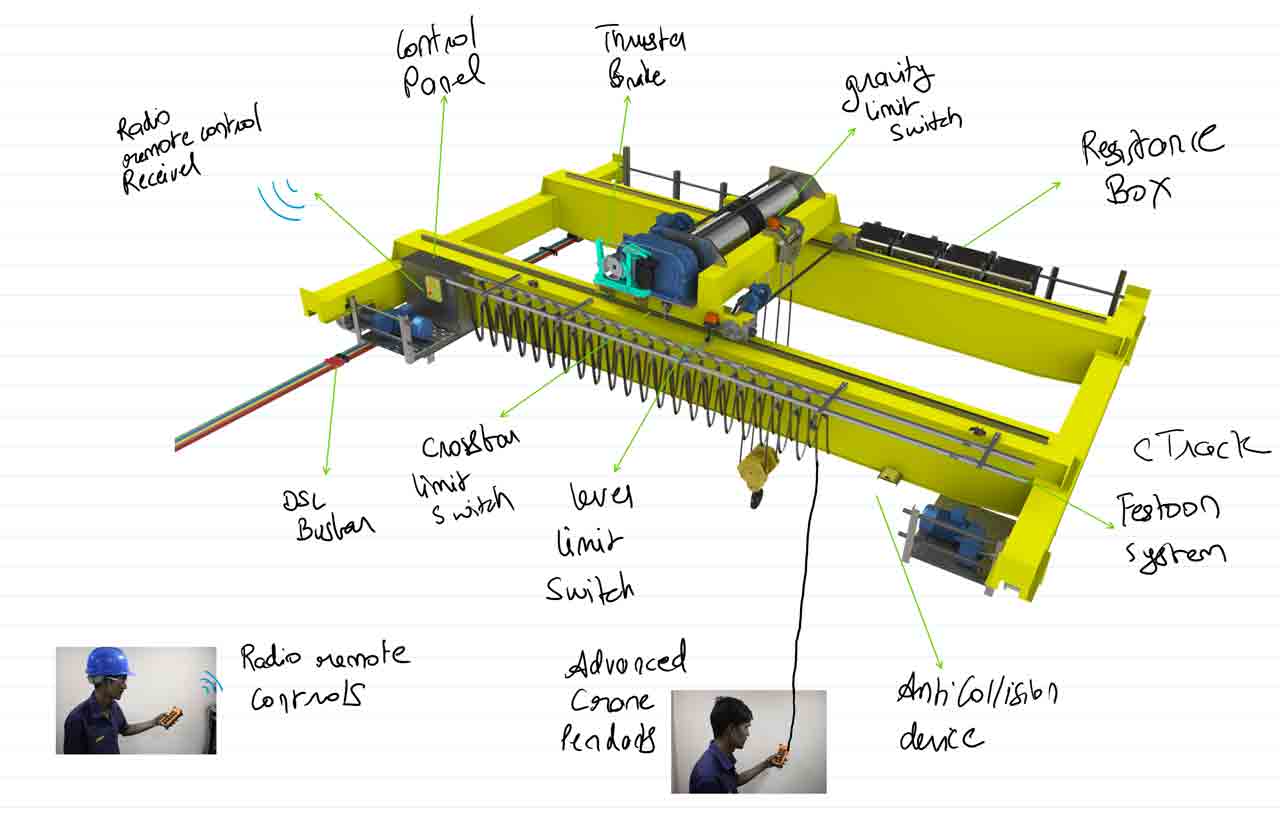
-
Hoist
![Parts of an EOT Cranes]() - The hoist is what creates the lift in lifting systems by holding, raising, or lowering the load using wire rope or chains.It is the most important component of the crane, and it must be able to handle the maximum weight of the load.
- The hoist is what creates the lift in lifting systems by holding, raising, or lowering the load using wire rope or chains.It is the most important component of the crane, and it must be able to handle the maximum weight of the load.
-
Trolley
![Hoisting UP & Down direction of an EOT Cranes]() - Trolley’s support the hoist and moves along the crane’s bridge. Trolleys can be configured to be top-running or bottom-running and can be within a track system or run on a beam.The trolley is responsible for moving the load horizontally.
- Trolley’s support the hoist and moves along the crane’s bridge. Trolleys can be configured to be top-running or bottom-running and can be within a track system or run on a beam.The trolley is responsible for moving the load horizontally.
-
Bridge
![Hoisting UP & Down direction of an EOT Cranes]() - It’s a primary structural component of a lift that connects the runways and holds the hoists and trolleys, also a load-bearing component that runs the width of the crane system.
- It’s a primary structural component of a lift that connects the runways and holds the hoists and trolleys, also a load-bearing component that runs the width of the crane system.
-
Columns
![Hoisting UP & Down direction of an EOT Cranes]() - If the crane support system isn’t part of the building it will need columns to support it. How high your columns are will determine your headroom and how high your lift can go.
- If the crane support system isn’t part of the building it will need columns to support it. How high your columns are will determine your headroom and how high your lift can go.
-
Runway
![Hoisting UP & Down direction of an EOT Cranes]() - Runways are what the bridge travels along and move the crane up and down the bays.
- Runways are what the bridge travels along and move the crane up and down the bays.
-
End Effectors
![Hoisting UP & Down direction of an EOT Cranes]() - End effectors are the “grab” part of the crane system.They are responsible for gripping and releasing the load.
- End effectors are the “grab” part of the crane system.They are responsible for gripping and releasing the load.
-
Reinforced-steel cable
![Hoisting UP & Down direction of an EOT Cranes]() - Reinforced-steel cable lines run from a winch just behind the operator's cab, extending up and over the boom and jib.
- Reinforced-steel cable lines run from a winch just behind the operator's cab, extending up and over the boom and jib.
-
Hook
![Hoisting UP & Down direction of an EOT Cranes]() - The load is supported using a hook that connects to the hoist and to the end effector.
- The load is supported using a hook that connects to the hoist and to the end effector.
-
Master Controllers
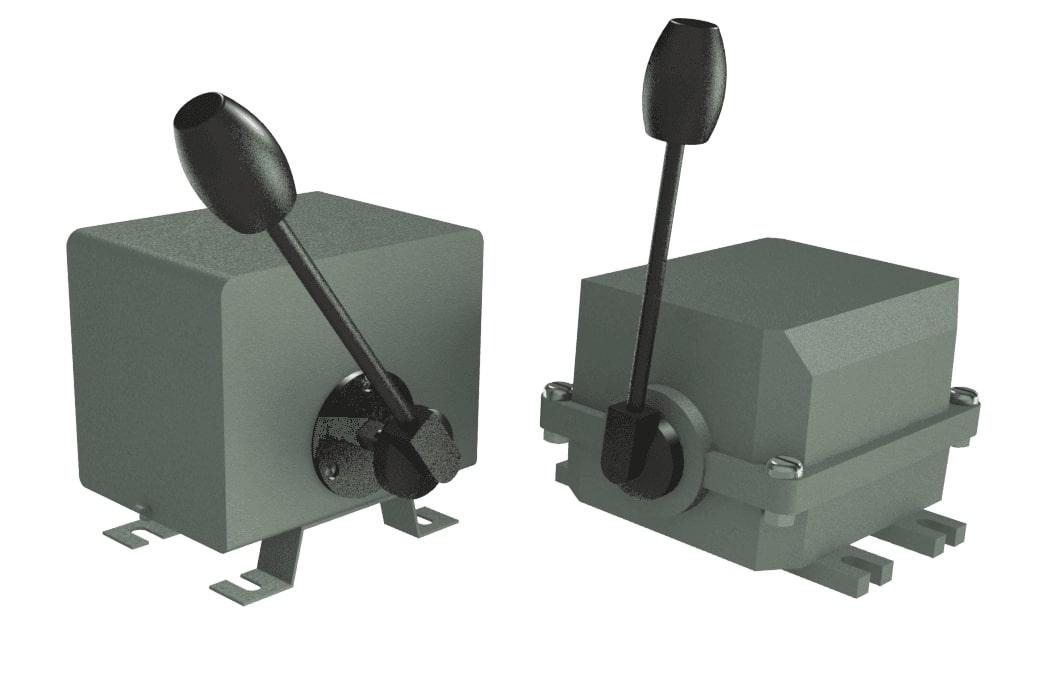 - There are two master Controllers in the cab. One controls the left-to-right movement of the boom, and the other controls forward and backward movement.
- There are two master Controllers in the cab. One controls the left-to-right movement of the boom, and the other controls forward and backward movement.
-
Electrical Control Panel
![Control Panel of an EOT Cranes]() - Control Panel of EOT Crane is a steel box containing all the motor driving equipment such as VFDs , contactors , fuses , switches & all connections to limit switches.This is the heart of the crane control system and is responsible for controlling all the electrical functions of the crane.
- Control Panel of EOT Crane is a steel box containing all the motor driving equipment such as VFDs , contactors , fuses , switches & all connections to limit switches.This is the heart of the crane control system and is responsible for controlling all the electrical functions of the crane.
-
DSL Busbars
![DSL Busbars of an EOT Cranes]() - Busbars are made up of highly electrically conductive metals and they distribute & carry power from a source to a destination or multiple destinations.They are used in EOT Cranes to supply power from the grid to the crane control panel.
- Busbars are made up of highly electrically conductive metals and they distribute & carry power from a source to a destination or multiple destinations.They are used in EOT Cranes to supply power from the grid to the crane control panel.
-
Radio Remote Control
![Crane Remote Control for EOT Cranes]() - Radio
remote controls wirelessly control EOT Cranes from a safe distance.This allows the operator to control the crane from a remote location, such as the ground or a nearby control room.
- Radio
remote controls wirelessly control EOT Cranes from a safe distance.This allows the operator to control the crane from a remote location, such as the ground or a nearby control room.
-
Pendant
- Pendant controls are wired control of an EOT crane.They are connected to the crane control system by a cable and allow the operator to control the crane.
Motions of an EOT Crane
- the EOT Crane can move in 3 directions with the help of electric Motors-
-
Hoisting Travel:
![Hoisting UP & Down direction of an EOT Cranes]() - Hoisting Motion Travel is used to take the hoist up and down.
- Hoisting Motion Travel is used to take the hoist up and down.
-
Cross Travel:
![Cross Travel of an EOT Cranes]() - Cross travel is used to take the hoist left or right.
- Cross travel is used to take the hoist left or right.
-
Long Travel:
![Long Travel of an EOT Cranes]() - Long travel is used to take the crane forward or backward.
- Long travel is used to take the crane forward or backward.
Features of EOT Cranes
EOT Cranes are designed to be highly efficient and safe, and they have several features that make them ideal for industrial applications. High Efficiency - EOT Cranes are highly efficient and can handle heavy loads with ease. They use advanced technology such as VFDs and advanced control systems to ensure that the crane is operating at its maximum efficiency at all times. Safety - EOT Cranes have many safety features such as emergency stop buttons, limit switches, and overload protection to ensure the safety of the operator and the load. They also have built-in safety features such as anti-collision systems to prevent accidents. Easy Maintenance - EOT Cranes are easy to maintain and have a long service life. They are designed to be easy to access and repair, and they require minimal maintenance. Customizable - EOT Cranes can be customized to suit the specific needs of the application. They can be configured with different hoists, trolleys, bridges, and control systems to meet the specific needs of the application.
- All the motors of an EOT Crane are electric motors..
- It consists of a heavy-duty cast steel rope guide.
- It has an upper and lower hook travel limit switch.
- The girder is made up of welded steel.
- The body of the EOT cranes is corrosion resistance.
- It offers easy operation with minimum maintenance.
Single Girder EOT (Electric Overhead Traveling) Crane

Single Girder EOT Crane has one main girder between the parallel runway. It consists of an electric hoist, which moves on the lower flange of the main girder. Single Girder EOT cranes do not need the rail component for moving on the parallel runway. Generally, single girder EOT cranes don’t have any platform. However, in some cases, it consists of 2 small platforms for LT (Long Travel) mechanism. It also consists of flanged mounted motors and vertical gearboxes. It can be operated through a push-button pendant station or radio remote control. However, these types of cranes cannot be operated by the cabin. The DC (Direct Current) Disc Brakes are used in all the movements of the cranes. The single girder cranes use a snap action limit switch, which is responsible for the movement of the hoist in an upward or downward direction. This switch is triggered by a wire rope guide. The single girder EOT crane is made up of 4-wheel arrangement in LT (Long Travel) end carriage. Because of this, the crane has a higher wheel load and also required heavy gantry girder, to improve the capacity. Single girder cranes are used in light applications such as handling normal material.
- In Comparison to double girder EOT crane, single girder EOT cranes are much lighter, as it consists of one main bridge.
- It is suited for light industrial applications.
- It has compact construction which minimizes the building loads.
- It can lift up to 20 tons of loads.
- It reduces the total crane cost on crane components, runway structure and building.
- Low head rooms reduce the cost of shed/building
- Its ergonomic design offers manual long travel (LT) because of its electric hoist or motorized chain pulley block.
Features of Single Girder EOT Crane
Double Girder EOT (Electric Overhead Traveling) Crane

Double girder EOT crane has two main girders between the parallel runway. It has a crab mechanism that travels above both the girders, which run over the rails. The rails with platforms are used to maintain all the parts of the crabs. The double girder cranes have the platform on both sides. This is used for maintenance purposes and platforms for crab maintenance. It consists of foot mounted motors with horizontal gearboxes. It is operated by push-button pendant station, radio remote, or operating cabin mode. In double girder EOT crane, a rotary limit switch is used to calculate the hook traveling and the up and down movement should be controlled accordingly. An additional limit switch is used such as gravity limit switch. The gravity limit switch is used for securing the limit switch working. Double girder EOT cranes have an 8-wheel arrangement, so that wheel load will be less at a particular point. These types of cranes are easy to maintain.
- As it consists of two main bridges, it becomes a sturdy and robust construction.
- It is specifically designed for assisting heavy-duty operations.
- It is cost-effective when compared to a single girder crane as it is capable of lifting heavy loads.
- It is utilized at any capacity, where a high hook lift is required. Because the hook can be pulled up between the girders.
- It has a lifting capacity of up to 250 tons.
- It consists of alloy steel, hardened, precision-cut gears.
- It consists of foot mounted hydraulic thruster brakes, which is used for the hoist.
- It has a full-length platform on the long travel drive of the side girder.
Features of Double Girder EOT Crane
Applications of EOT Cranes are vast.They are used in Many Industries.
- Ceramic Industries - EOT cranes are a valuable asset in the ceramic industry, as they are able to efficiently and effectively handle the heavy raw materials, molds, and finished products that are present in the manufacturing process. These cranes can be customized to suit the specific needs of the application, ensuring that all materials are handled with precision and care.
- Power Plants - EOT cranes play a crucial role in power plants, where they are used to move heavy equipment, such as generators and turbines, during maintenance and repair. These cranes are able to handle large loads with ease and are equipped with safety features such as emergency stop buttons, limit switches, and overload protection to ensure the safety of the operator and the load.
- Transport Industry - EOT cranes are an essential piece of equipment in the transport industry, as they are used to efficiently load and unload cargo from trains, trucks and ships. They are able to handle large and heavy loads with ease and can be operated remotely, increasing productivity and efficiency.
- Petrochemical Industry - EOT cranes are an integral part of petrochemical plants, as they are used to move heavy equipment and chemicals during the production process. They are designed to withstand harsh environments and are able to handle large loads with precision and accuracy.
- Chemical Industries - EOT cranes play a vital role in chemical manufacturing, as they are used to move heavy raw materials, chemicals, and finished products.
- Steel Plant - EOT cranes are a crucial piece of equipment in steel production, as they are used to move heavy steel beams, slabs, and finished products. These cranes are able to handle large loads with ease and are equipped with safety features such as emergency stop buttons, limit switches, and overload protection to ensure the safety of the operator and the load.
- Dairy Industries - EOT cranes are an important asset in the dairy industry, as they are used to move heavy equipment, such as milking machines and storage tanks, as well as heavy raw materials and finished products. These cranes are easy to maintain and have a long service life, ensuring that they are available when needed.
- Foundries - EOT cranes are a vital piece of equipment in foundries, as they are used to move heavy raw materials, molds, and finished products. These cranes are able to handle large loads with ease and are equipped with safety features such as emergency stop buttons, limit switches, and overload protection to ensure the safety of the operator and the load.
- Textile Industry - EOT cranes are a valuable asset in the textile industry, as they are used to move heavy raw materials, such as cotton and wool, as well as finished products, such as fabrics and clothing. These cranes are easy to maintain and have a long service life, ensuring that they are available when needed.
- Cement Industry - EOT cranes play a vital role in the cement industry, as they are used to move heavy raw materials, such as limestone and clay, and finished products, such as cement. These cranes are able to handle large loads with ease and are equipped with safety features such as emergency stop buttons, limit switches, and overload protection to ensure the safety of the operator and the load.
- In Assembly Line - EOT cranes are an essential piece of equipment in assembly lines, as they are used to move heavy equipment and materials during the manufacturing process. These cranes are highly efficient and can be customized to suit the specific needs of the application, ensuring that all materials are handled with precision and care.
- Paper and Packing - EOT cranes are a valuable asset in the paper and packing industry, as they are used to move heavy raw materials, such as wood pulp, and finished products, such as paper rolls and cardboard boxes. These cranes are easy to maintain and have a long service life, ensuring that they are available when needed.
- Petro-Chemical - EOT cranes are used in the petrochemical industry to move heavy equipment and chemicals during the production process.
- Shipbuilding - EOT cranes are used in ports and terminals for loading and unloading cargo from ships and transporting it to warehouses and other storage facilities. They are also used in loading and unloading cargo from railway cars and trucks. These cranes are highly efficient and can handle large loads with ease, increasing productivity and efficiency in the logistics industry.
- Fertilizers - EOT cranes are an important piece of equipment in the fertilizer industry, as they are used to move heavy raw materials, such as phosphates and potash, and finished products, such as fertilizer bags. These cranes are able to handle large loads with ease and are equipped with safety features such as emergency stop buttons, limit switches, and overload protection to ensure the safety of the operator and the load.
- Renewable Energy - EOT cranes play a vital role in the renewable energy industry, as they are used in facilities such as wind and solar power plants to move heavy equipment and materials during the construction and maintenance process. These cranes are able to handle large loads with ease and are equipped with safety features such as emergency stop buttons, limit switches, and overload protection to ensure the safety of the operator and the load. Additionally, these cranes are also used to maintain and service wind turbines, ensuring smooth and efficient operation of the power plant.
- Recycling - EOT cranes are an essential piece of equipment in the recycling industry, as they are used to move heavy waste materials and finished products. These cranes are able to handle large loads with ease and are equipped with safety features such as emergency stop buttons, limit switches, and overload protection to ensure the safety of the operator and the load. They are also designed to operate in harsh and demanding environments, making them ideal for use in recycling facilities.
- Marine - EOT cranes are an important piece of equipment in marine operations, as they are used in oil rigs and ports to move heavy equipment and materials. These cranes are able to handle large loads with ease and are equipped with safety features such as emergency stop buttons, limit switches, and overload protection to ensure the safety of the operator and the load. Additionally, these cranes are also designed to operate in harsh and demanding marine environments, making them ideal for use in ports and oil rigs.
- Pulp and Paper - EOT cranes play a vital role in the pulp and paper industry, as they are used in mills to move heavy raw materials, such as wood pulp, and finished products, such as paper rolls. These cranes are able to handle large loads with ease and are equipped with safety features such as emergency stop buttons, limit switches, and overload protection to ensure the safety of the operator and the load. Additionally, these cranes are also designed to operate in harsh and demanding environments, making them ideal for use in pulp and paper mills.
- Waste Management - EOT cranes are an essential piece of equipment in the waste management industry, as they are used to move heavy waste materials and finished products. These cranes are able to handle large loads with ease and are equipped with safety features such as emergency stop buttons, limit switches, and overload protection to ensure the safety of the operator and the load. They are also designed to operate in harsh and demanding environments, making them ideal for use in waste management facilities.
- Agriculture - EOT cranes play a crucial role in the agriculture industry, as they are used to move heavy equipment, such as tractors and harvesters, and materials, such as hay bales and grain. These cranes are able to handle large loads with ease and are equipped with safety features such as emergency stop buttons, limit switches, and overload protection to ensure the safety of the operator and the load. Additionally, these cranes are also designed to operate in harsh and demanding environments, making them ideal for use in agriculture operations.
Malfunctions of EOT Cranes.
-
Damaged wires/ropes
![damaged wire rope eot crane]() - Many times , wire ropes are frayed, kinked or broken . Due to wear and tear wire rope diameter also reduces.
This can put the lives of the workers at risk due to high probability of the falling of the product from the hook.
- Many times , wire ropes are frayed, kinked or broken . Due to wear and tear wire rope diameter also reduces.
This can put the lives of the workers at risk due to high probability of the falling of the product from the hook.
-
Electrical dangers or fault in power circuit
![electrical_faults of an EOT Cranes]() - Electricity is dangerous . Due to fault in wiring or control panel , high current can flow which can damage the motors ,VFDs & any other electrical equipment.
- Electricity is dangerous . Due to fault in wiring or control panel , high current can flow which can damage the motors ,VFDs & any other electrical equipment.
-
Hooks getting bent or damage
![bent hook of an EOT Cranes]() - Hooks getting bent or damaged can be a serious issue and it can be a risk for life . Workers must check for this for safety reasons before lifting any load. They should look for any damage such as cracks , bending or stretching.
- Hooks getting bent or damaged can be a serious issue and it can be a risk for life . Workers must check for this for safety reasons before lifting any load. They should look for any damage such as cracks , bending or stretching.
-
4. Crane Skew or Alignment issues
![bent hook of an EOT Cranes]() - Crane Skew can give you a costly expense if it’s not looked properly. It will give different hints if there is an alignment issues such as thumping, grinding, loud scratching, If the power usage is more and even if crane is dragging or lulling in position.
- Crane Skew can give you a costly expense if it’s not looked properly. It will give different hints if there is an alignment issues such as thumping, grinding, loud scratching, If the power usage is more and even if crane is dragging or lulling in position.
-
5. Overheating
Overheating can occur in the crane's motors or other electrical components, leading to damage or failure. -
6. Load Balancing Issues
Improperly balanced loads can lead to damage or failure of the crane. -
7. Weather Damage
EOT Cranes are often used in outdoor environments and can suffer from weather-related damage, such as rust and corrosion from exposure to the elements.
Comparison of EOT Cranes with Other Types of Cranes
Electric Overhead Traveling (EOT) cranes are a popular type of crane used in various industries for moving heavy loads. However, they are not the only option available. In this article, we will compare EOT cranes to other types of cranes such as gantry cranes, jib cranes, and monorail cranes to help businesses make an informed decision when choosing the right crane for their specific needs.
-
Gantry Cranes
Gantry cranes are similar to EOT cranes in that they both consist of a bridge that spans the width of a bay and a trolley that runs along the bridge. However, gantry cranes are supported by legs rather than a building structure. This makes them more versatile, as they can be used both indoors and outdoors. Gantry cranes are also typically larger and can handle heavier loads than EOT cranes. On the other hand, EOT cranes have the advantage of being able to utilize the existing building structure for support, which can save on costs and increase the available headroom.
-
Monorail Cranes
Monorail cranes consist of a single beam that runs the length of the bay, with a trolley running along the beam. They are similar to EOT cranes in that they both have a bridge and trolley, but monorail cranes do not have the additional overhead structure of EOT cranes. This makes them more cost-effective and easier to install. However, monorail cranes are limited in their capacity and are typically used for lighter loads and shorter spans. EOT cranes, on the other hand, can handle heavier loads and longer spans, and can utilize the existing building structure for support.
Jib Cranes
Jib cranes are smaller than EOT cranes and are typically used for smaller loads and shorter spans. They consist of a horizontal boom that is mounted on a vertical mast and can rotate 360 degrees. Jib cranes are ideal for applications where space is limited and a small footprint is required. EOT cranes, on the other hand, are better suited for larger loads and longer spans, and can cover a wider area.
EOT cranes, gantry cranes, jib cranes, and monorail cranes all have their own unique advantages and disadvantages. Businesses should carefully consider their specific needs and requirements before choosing the right crane for their application. EOT cranes are ideal for heavy loads and long spans, and can utilize the existing building structure for support. Gantry cranes are versatile and can be used both indoors and outdoors, but are typically larger and more expensive. Jib cranes are ideal for small loads and short spans in limited space, while monorail cranes are cost-effective and easy to install but are limited in their capacity.
Conclusion
EOT cranes offer reliability, safety, and better speed. EOT cranes are used for wide applications such as Ceramic Industries, Power Plant, Cement Industry, etc. It can be used to lift light weights as well as heavy loads. EOT can reduce the man power required as compared with the Gantry, Monorail, Goliath, Jib cranes and also the cost gets reduced due to easy handling of EOT crane. EOT crane can be operated with Radio Remote controls which makes it less risky for the crane operator. EOT cranes have low maintenance equipment . Double Girder crane has the capacity to lift up to 250 tons and single girder crane has the capacity of 20 tons.
Anand Systems Engineering is an Indian manufacturer of Radio Remote Control systems for Cranes and Hoists with a Goal of modernizing Indian Engineering.
Follow us on YouTube.
 - The hoist is what creates the lift in lifting systems by holding, raising, or lowering the load using wire rope or chains.It is the most important component of the crane, and it must be able to handle the maximum weight of the load.
- The hoist is what creates the lift in lifting systems by holding, raising, or lowering the load using wire rope or chains.It is the most important component of the crane, and it must be able to handle the maximum weight of the load.
 - Trolley’s support the hoist and moves along the crane’s bridge. Trolleys can be configured to be top-running or bottom-running and can be within a track system or run on a beam.The trolley is responsible for moving the load horizontally.
- Trolley’s support the hoist and moves along the crane’s bridge. Trolleys can be configured to be top-running or bottom-running and can be within a track system or run on a beam.The trolley is responsible for moving the load horizontally.
 - It’s a primary structural component of a lift that connects the runways and holds the hoists and trolleys, also a load-bearing component that runs the width of the crane system.
- It’s a primary structural component of a lift that connects the runways and holds the hoists and trolleys, also a load-bearing component that runs the width of the crane system.
 - If the crane support system isn’t part of the building it will need columns to support it. How high your columns are will determine your headroom and how high your lift can go.
- If the crane support system isn’t part of the building it will need columns to support it. How high your columns are will determine your headroom and how high your lift can go.
 - Runways are what the bridge travels along and move the crane up and down the bays.
- Runways are what the bridge travels along and move the crane up and down the bays.
 - End effectors are the “grab” part of the crane system.They are responsible for gripping and releasing the load.
- End effectors are the “grab” part of the crane system.They are responsible for gripping and releasing the load.
 - Reinforced-steel cable lines run from a winch just behind the operator's cab, extending up and over the boom and jib.
- Reinforced-steel cable lines run from a winch just behind the operator's cab, extending up and over the boom and jib.
 - The load is supported using a hook that connects to the hoist and to the end effector.
- The load is supported using a hook that connects to the hoist and to the end effector.
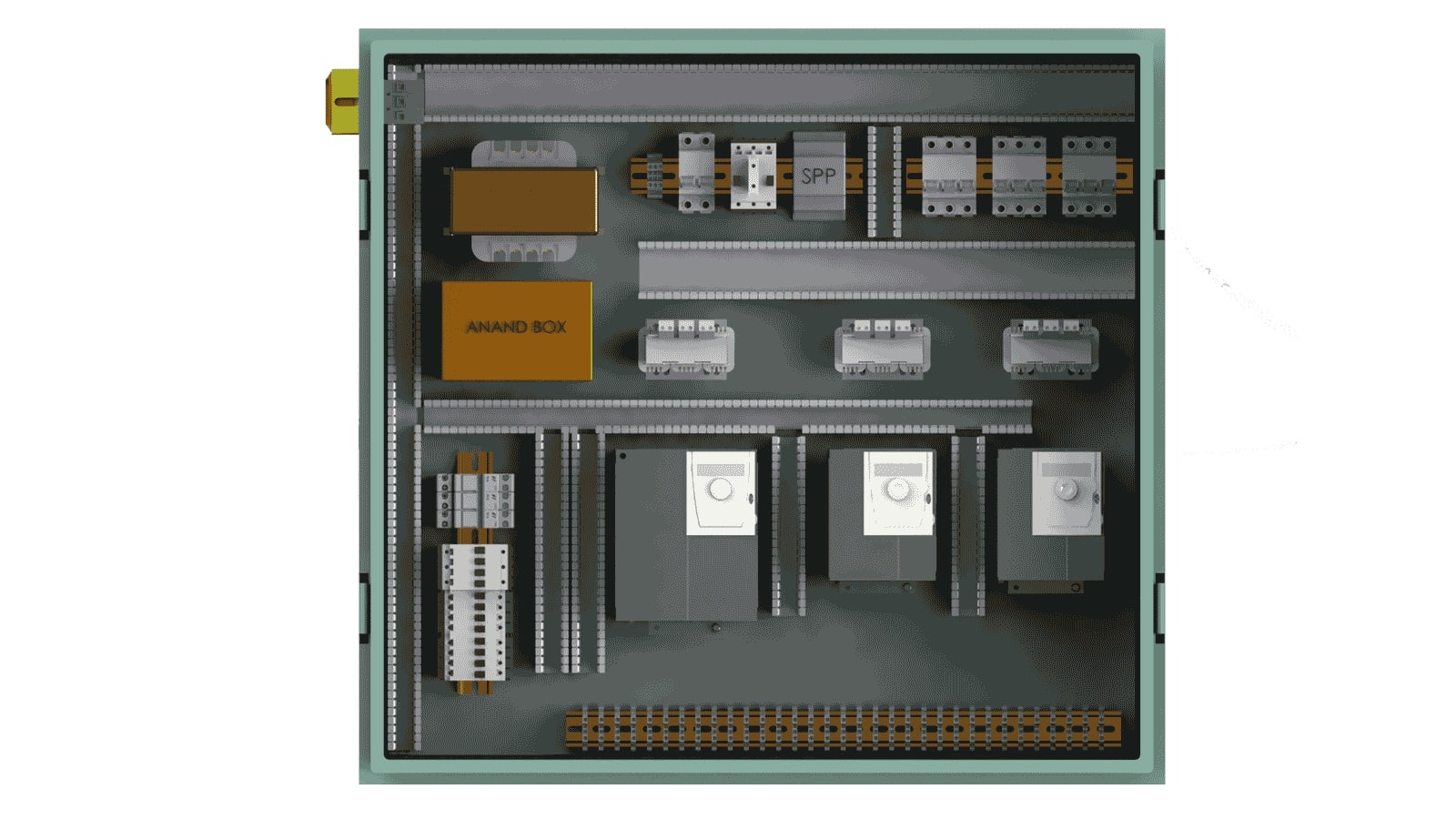 - Control Panel of EOT Crane is a steel box containing all the motor driving equipment such as VFDs , contactors , fuses , switches & all connections to limit switches.This is the heart of the crane control system and is responsible for controlling all the electrical functions of the crane.
- Control Panel of EOT Crane is a steel box containing all the motor driving equipment such as VFDs , contactors , fuses , switches & all connections to limit switches.This is the heart of the crane control system and is responsible for controlling all the electrical functions of the crane.
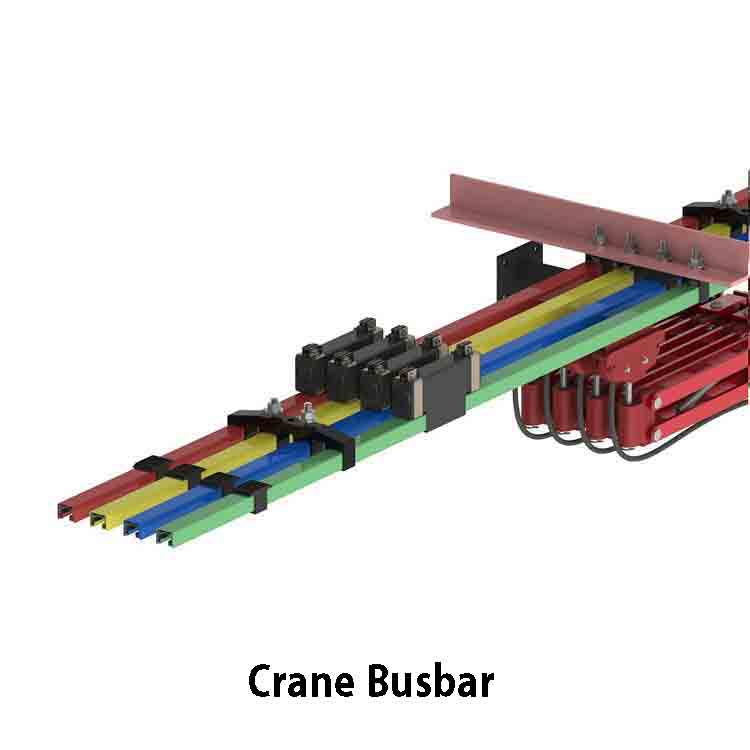 - Busbars are made up of highly electrically conductive metals and they distribute & carry power from a source to a destination or multiple destinations.They are used in EOT Cranes to supply power from the grid to the crane control panel.
- Busbars are made up of highly electrically conductive metals and they distribute & carry power from a source to a destination or multiple destinations.They are used in EOT Cranes to supply power from the grid to the crane control panel.
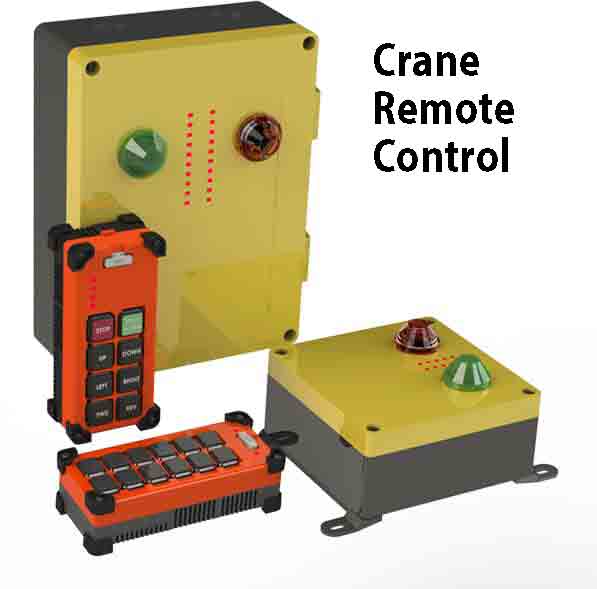 - Radio
remote controls wirelessly control EOT Cranes from a safe distance.This allows the operator to control the crane from a remote location, such as the ground or a nearby control room.
- Radio
remote controls wirelessly control EOT Cranes from a safe distance.This allows the operator to control the crane from a remote location, such as the ground or a nearby control room.
 - Hoisting Motion Travel is used to take the hoist up and down.
- Hoisting Motion Travel is used to take the hoist up and down.
 - Cross travel is used to take the hoist left or right.
- Cross travel is used to take the hoist left or right.
 - Long travel is used to take the crane forward or backward.
- Long travel is used to take the crane forward or backward.
 - Many times , wire ropes are frayed, kinked or broken . Due to wear and tear wire rope diameter also reduces.
This can put the lives of the workers at risk due to high probability of the falling of the product from the hook.
- Many times , wire ropes are frayed, kinked or broken . Due to wear and tear wire rope diameter also reduces.
This can put the lives of the workers at risk due to high probability of the falling of the product from the hook.
 - Electricity is dangerous . Due to fault in wiring or control panel , high current can flow which can damage the motors ,VFDs & any other electrical equipment.
- Electricity is dangerous . Due to fault in wiring or control panel , high current can flow which can damage the motors ,VFDs & any other electrical equipment.
 - Hooks getting bent or damaged can be a serious issue and it can be a risk for life . Workers must check for this for safety reasons before lifting any load. They should look for any damage such as cracks , bending or stretching.
- Hooks getting bent or damaged can be a serious issue and it can be a risk for life . Workers must check for this for safety reasons before lifting any load. They should look for any damage such as cracks , bending or stretching.
 - Crane Skew can give you a costly expense if it’s not looked properly. It will give different hints if there is an alignment issues such as thumping, grinding, loud scratching, If the power usage is more and even if crane is dragging or lulling in position.
- Crane Skew can give you a costly expense if it’s not looked properly. It will give different hints if there is an alignment issues such as thumping, grinding, loud scratching, If the power usage is more and even if crane is dragging or lulling in position.
